-
Paper Information
- Next Paper
- Previous Paper
- Paper Submission
-
Journal Information
- About This Journal
- Editorial Board
- Current Issue
- Archive
- Author Guidelines
- Contact Us
American Journal of Mathematics and Statistics
p-ISSN: 2162-948X e-ISSN: 2162-8475
2012; 2(3): 22-26
doi: 10.5923/j.ajms.20120203.02
On Complementary Edge Magic Labeling ofCertain Graphs
1Research Scholar, India
2Academic Dean, HMS institute of Technology, Tumkur, Karnataka, India
Correspondence to: Sanjay Roy , Research Scholar, India.
| Email: |  |
Copyright © 2012 Scientific & Academic Publishing. All Rights Reserved.
By G(p, q) we denote a graph having p vertices and q edges, by V(G) and E(G) the vertex set and the edge – set of G respectively. But the vertices and edges are called the elements of the graph. A (p, q) – graph G is called the edge – magic if there exists a bijective function f: V(G) U E(G)→{1,2, ,p+q} such that f(u)+f(v)+f(uv)=k is a constant called the valence of f for any edge uv of G. Given an edge magic f of a graph G(p, q) the function such that =p+q+1-f(x) for all elements of G is said to be complementary to f(x) or complementary edge magic labeling . The purpose of this article is to search for certain graphs Km, n (m, n ≥ 1), Cn (n ≥ 3), np2, f n (fan) Bn (bwk) and nG (n ≥ 2) where G is bipartite or tripartite which have complementary edge magic strength.
Keywords: Edge-Magic Labeling, Complementary Edge Magic Labeling, 1991 Mathematics Subject Classification. O5C78
1. Introduction
- The subject of edge – magic labelings of graphs had its origins three decades ago in the work of Kotzing and Rosa [9,10] on what they called magic valuations of graphs (which are also commonly known as edge-magic total labeling see[4]). Interest in these labelings has been lately rekindled by a paper on the subject due to Ringel and Llado[11]. Shortly after this, Enomoto, Llado, Nakamigawa and Ringel[3] defined a more restrictive form of edge-magic labelings namely super edge magic labelings which Wallis[12] refers to as strong edge – magic labelings.
2. Objective
- By G(p, q), we denote a graph having p vertices and q edge, by V(G) and E(G), the vertex set and the edge-set of G respectively. But the vertices and edges are called the elements of the graph G. A graph(p, q) is said to have an edge magic with the magic constant k (which is independent on the choice of any edge uv of G) if there exists a one one– to –one mapping f:V(G) U E(G) à {1, 2, p+q} such that f(u) + f(v) +f(uv) =k for all uv ∈ E (G). If such a labeling exists, then magic constant k is called valence of f and G is said to be edge –magic graph. Given an edge magic f of a graph G (p, q), the Function f(x) such that
 = p+q+1-f(x) for all elements x ∈G is said to be complementary to f(x).Two edge magic f1 and f2 of G are equivalent if f1=f2 or f1=
= p+q+1-f(x) for all elements x ∈G is said to be complementary to f(x).Two edge magic f1 and f2 of G are equivalent if f1=f2 or f1= . An edge magic f of G is said to be self complementary edge magic if f=
. An edge magic f of G is said to be self complementary edge magic if f=
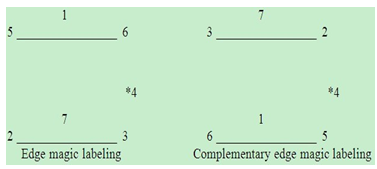 | Figure 1. |
 where the minimum is taken over all complementary edge magic labeling of G. cems (G) = min {
where the minimum is taken over all complementary edge magic labeling of G. cems (G) = min { :
:  is an complementary edge magic labeling of G}.
is an complementary edge magic labeling of G}.3. Methods
- In this paper, the complementary edge magic strength of some well known graphs such as Km, n (m,n ≥ 1), Cn (n ≥ 3), np2 (n ≥ 1), fn, Bn and nG (n ≥ 2) where G is bipartite or tripartite are obtained. The reader is directed to Chartered and Lesniak[2] or Hartefield and Ringel[8] for all additional terminology not provided in this paper. The following theorem is every useful for the main results.Theorem A[1] An complementary edge – magic graph G satisfies the following equation
 where
where  is complementary edge magic labeling of G and T=p+q.
is complementary edge magic labeling of G and T=p+q.4. Results
- Main ResultsIn this section we proceed to study the complementary edge magic strength of Km, n, Cn, fn=Pn+k1 and Bn = K1, n x K2 and nG, where G is bipartite or tripartite.Theorem1. A complete bipartite graph Km, n is complementary edge magic strength if m, n ≥ 1.Proof: Let G be a complete bipartite graph Km, n with vertex set V partitioned into two subject V1 and V2 where V1={u1, u2, um} and V2={v1,v2, vn} andlet f: VUEà {1,2, ,m+n+mn}Then,f (vi) = m+n+mn+1-i f(vj) = mxn+n+1 – (m+1)jf(aibj) = -m+(m+1)j +iIt is easy to see that f extends to a complementary edge magic labeling of Km, n with the magic constant
 .
. = f(vi) + f (vj) + f(aibj)= [m+n+mn+1-i] + [mn+n+1 – (m+1)j] + [-m+(m+1)j +i]= 2mn+2n+2= 2(mn+n+1)Complementary edge magic strength: Now by Theorem A
= f(vi) + f (vj) + f(aibj)= [m+n+mn+1-i] + [mn+n+1 – (m+1)j] + [-m+(m+1)j +i]= 2mn+2n+2= 2(mn+n+1)Complementary edge magic strength: Now by Theorem A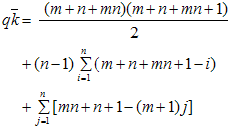
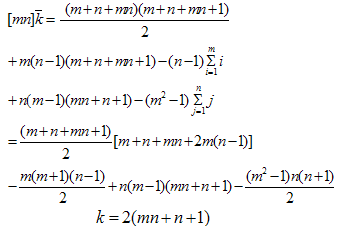 Thus scems (K m, n) = 2(mn+n+1)The following theorem is the complementary edge magic strength of cycle Cn for every integer n ≥ 3.Theorem2. The cycle Cn is complementary edge magic and complementary edge magic strength is
Thus scems (K m, n) = 2(mn+n+1)The following theorem is the complementary edge magic strength of cycle Cn for every integer n ≥ 3.Theorem2. The cycle Cn is complementary edge magic and complementary edge magic strength is  where n is an integer. Proof: Let C be the cycle with V (Cn) = {v i: 1 ≤ i ≤ n} and E (Cn) = {vi: v i+1 : 1 ≤ i ≤ n2} where i is taken modulo n (replacing o by n) We discuss the following cases.Case I: n is odd say n=2m +1 where m is positive integer.Consider the function f: V(G) U E (G) à {1,2,2n}Defined as
where n is an integer. Proof: Let C be the cycle with V (Cn) = {v i: 1 ≤ i ≤ n} and E (Cn) = {vi: v i+1 : 1 ≤ i ≤ n2} where i is taken modulo n (replacing o by n) We discuss the following cases.Case I: n is odd say n=2m +1 where m is positive integer.Consider the function f: V(G) U E (G) à {1,2,2n}Defined as  and,
and, Since we have
Since we have  f (Vi) = {2,4,6,10,….2n}
f (Vi) = {2,4,6,10,….2n} f (v i v i+1) = {1,3,5.(2n-1)}f (vn) + f (v1) + f (vnv1) = 2n+(n+1)+1 = 3n+2f (v i)+ f (v i+1) + f (v i v i+1) = (2n+1- i ) + (n-i) + (1+2i) =3n+2 for i=1,2, n-1Thus f is a complementary edge magic of cycle Cn with magic constant 3n+2Complementary edge – magic string:
f (v i v i+1) = {1,3,5.(2n-1)}f (vn) + f (v1) + f (vnv1) = 2n+(n+1)+1 = 3n+2f (v i)+ f (v i+1) + f (v i v i+1) = (2n+1- i ) + (n-i) + (1+2i) =3n+2 for i=1,2, n-1Thus f is a complementary edge magic of cycle Cn with magic constant 3n+2Complementary edge – magic string: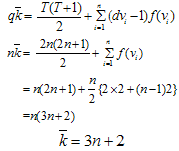 Case 2. n ≡ o (mod 4) say n = 4l where l is the positive integer, f is defined as
Case 2. n ≡ o (mod 4) say n = 4l where l is the positive integer, f is defined as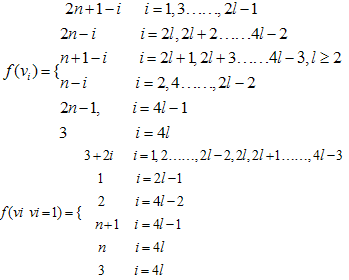 Clearly
Clearly  f(vi) = { 4,6,8,…..2n-4,2n} U {n+1, 2n-1}
f(vi) = { 4,6,8,…..2n-4,2n} U {n+1, 2n-1} f(vivi+1) = { 1,3,5,…..n-1, n+3,n+5,…,2n-3} U {2, 2n-2}Next we prove thatf(vi)+f(vi+1)+f(vivi+1) =
f(vivi+1) = { 1,3,5,…..n-1, n+3,n+5,…,2n-3} U {2, 2n-2}Next we prove thatf(vi)+f(vi+1)+f(vivi+1) =  for all i = 1,2,..,4lSub case 2.1 Let i ∈ {4, 6, 8.., 2n-4,2n} U {n+1,2n-1} Thenf (vi)+f (vi+1)+f (vivi+1) = (2n+1-i)+(n-i-1)+(3+2i) =3(n+1)Sub case 2.2 Let i = 2l-1 thenf (v2l-1)+f (v2l)+ f (v2l-1v2l)=(2n-2l+2)+(2n-2l)+1=3(n+1)Sub case 2.3 Let i ∈ {2l, 2l+2,…, 4l-4} Thenf (vi)+f (vi+1)+f (vivi+1) = (2n-i)+(n-i)+3+2i=3(n+1)Sub case 2.4 Let i = 2l-2 Thenf (v4l-2)+f (v4l-1)+f (v4l-2 v4l-1)=(2n+2)+(2n-1)+2=3(n+1)Sub case 2.5 Let I ∈ {2l+1, 2l+3,..,4l-3}, Thenf (vi)+f(vi+1)+f (vivi+1) = (n+1-i)+(2n-1-i)+(3+2i)=3(n+1)Sub case 2.6 Let i ∈ {2l+1, 2l+3,…4l-3} Thenf (vi)+f (vi+1) + f (vivi+1)= (n-i)+(2n-i)+(3+2i)=3(n+1)Sub case 2.7 Let i = 4l-1. Thenf (v4l-1)+f (v4l)+f (v4l-1v4l)=(2n-1)+(3)+(n+1)=3(n+1)Sub case 2.8 Let i = 4l. Thenf (v4l)+f(v1)+f (v4lv1)= 3+(2n)+n=3(n+1)Therefore
for all i = 1,2,..,4lSub case 2.1 Let i ∈ {4, 6, 8.., 2n-4,2n} U {n+1,2n-1} Thenf (vi)+f (vi+1)+f (vivi+1) = (2n+1-i)+(n-i-1)+(3+2i) =3(n+1)Sub case 2.2 Let i = 2l-1 thenf (v2l-1)+f (v2l)+ f (v2l-1v2l)=(2n-2l+2)+(2n-2l)+1=3(n+1)Sub case 2.3 Let i ∈ {2l, 2l+2,…, 4l-4} Thenf (vi)+f (vi+1)+f (vivi+1) = (2n-i)+(n-i)+3+2i=3(n+1)Sub case 2.4 Let i = 2l-2 Thenf (v4l-2)+f (v4l-1)+f (v4l-2 v4l-1)=(2n+2)+(2n-1)+2=3(n+1)Sub case 2.5 Let I ∈ {2l+1, 2l+3,..,4l-3}, Thenf (vi)+f(vi+1)+f (vivi+1) = (n+1-i)+(2n-1-i)+(3+2i)=3(n+1)Sub case 2.6 Let i ∈ {2l+1, 2l+3,…4l-3} Thenf (vi)+f (vi+1) + f (vivi+1)= (n-i)+(2n-i)+(3+2i)=3(n+1)Sub case 2.7 Let i = 4l-1. Thenf (v4l-1)+f (v4l)+f (v4l-1v4l)=(2n-1)+(3)+(n+1)=3(n+1)Sub case 2.8 Let i = 4l. Thenf (v4l)+f(v1)+f (v4lv1)= 3+(2n)+n=3(n+1)Therefore  is a complementary edge magic of the cycle Cn with the magic Constant
is a complementary edge magic of the cycle Cn with the magic Constant = 3 (n+1)Complementary edge magic strength:
= 3 (n+1)Complementary edge magic strength: Case 3. n ≡ 2 (mod 4) that is n = 4l+2. Define the function
Case 3. n ≡ 2 (mod 4) that is n = 4l+2. Define the function Since
Since  {f vi } = { 4l + 2, 4l+3,….., 6l+1, 6l+2,6l+4,6l+5,……8l+4}
{f vi } = { 4l + 2, 4l+3,….., 6l+1, 6l+2,6l+4,6l+5,……8l+4} {f (vi vi+1)} = { 1,2,…,4l, 4l+1, 6l+3}Next we prove that f (vi)+f (vi+1)+ f (vivi+1) =
{f (vi vi+1)} = { 1,2,…,4l, 4l+1, 6l+3}Next we prove that f (vi)+f (vi+1)+ f (vivi+1) =  for all i = 1,2,4l+2Subcase 3.1 Let i = 1 Thenf (vi)+f (vi+1)+ f (vivi+1)= 2n+(2n-6l-2)+(2n-4l-2)=2 (3n-5l-2)=(7n+2)/2Sub case 3.2 Let i = {3,5,..,2l-1} Thenf (vi)+f (vi+1)+f (vivi+1)= (2n+1/2 – i/2)+ {2n-2l-1- (i+1)/2}+(2n-8l-3-i)= 2 (3n-5l-2)= (7n+2)/2Sub case 3.3 Let i = 2l+1. Thenf (v2l+1)+ f (v2l+2)+f (v2l+1v2l+2)= (2n-1)(2n-l-1)+(2n-8l-3)=3(2n-5l-2)=(7n+2)/2Sub case 3.4 Let i = {2l+3, 2l+5,…, 4l-1} Thenf (vi)+f (vi+1)+f (vivi+1)= (2n-1/2-i/2)+{2n-2l-1-(i-1)/2)+(2n-8l-3+i)= 6n-10l-4 =2 (3n-5l-2) = (7n+2)/2Sub case 3.5 Let i = 4l+1. Thenf (v4l+1)+f (v4l+2)+f (v4l+1,v4l+2)= (2n-1/2- (4l+1)/2)+(2n-2l-2)+(2n-6l-1)= 6n-10l-4 =2 (3n-5l-2) = (7n+2)/2 Sub case 3.6 Let i = 2. Then f (v2)+f (v2)+f (v2v3)= (2n-6l-2)+(2n-1)+(2n-4l+1)= 6n-10l-4 = 2 (3n-5l-2) =(7n+2)/2Sub case 3.7 Let i = 2k+2. Then f (v2l+2) + f (v2l+3) + f (v2l+2v2l+3) = (2n-l-1)+(2n-l-1)+(2n-8l-1)=2(3n-5l-2)= (7n+2)/2Sub case 3.8 Let i = 4l+2. Thenf (v4l+2)+f (v1)+f (v4l+2v1)= (2n-2l-2)+(2n+1)+(2n-6l-2)=2(3n-5l-2) =(7n+2)/2Sub case 3.9 Let i ∈ {4,6,…2k}. Thenf (vi)+f (vi+1)+f (vivi+1)= (2n-2l-1-i/2) +(2n-i/2)+(2n-8l-3+i)= 2(3n-5l-2)= (7n+2)/2Sub case 3.10 Let i ∈ {2l+4, 2l+6,….4l}. Thenf (vi)+f (vi+1)+f (vivi+1)= (2n-2l-i/2) +(2n-1-i/2)+(2n-8l-3+i)=2 (3n-5l-2)=(7n+2)/2 Thus f is a complementary edge magic function of the cycle C4l+2 with the magic constant
for all i = 1,2,4l+2Subcase 3.1 Let i = 1 Thenf (vi)+f (vi+1)+ f (vivi+1)= 2n+(2n-6l-2)+(2n-4l-2)=2 (3n-5l-2)=(7n+2)/2Sub case 3.2 Let i = {3,5,..,2l-1} Thenf (vi)+f (vi+1)+f (vivi+1)= (2n+1/2 – i/2)+ {2n-2l-1- (i+1)/2}+(2n-8l-3-i)= 2 (3n-5l-2)= (7n+2)/2Sub case 3.3 Let i = 2l+1. Thenf (v2l+1)+ f (v2l+2)+f (v2l+1v2l+2)= (2n-1)(2n-l-1)+(2n-8l-3)=3(2n-5l-2)=(7n+2)/2Sub case 3.4 Let i = {2l+3, 2l+5,…, 4l-1} Thenf (vi)+f (vi+1)+f (vivi+1)= (2n-1/2-i/2)+{2n-2l-1-(i-1)/2)+(2n-8l-3+i)= 6n-10l-4 =2 (3n-5l-2) = (7n+2)/2Sub case 3.5 Let i = 4l+1. Thenf (v4l+1)+f (v4l+2)+f (v4l+1,v4l+2)= (2n-1/2- (4l+1)/2)+(2n-2l-2)+(2n-6l-1)= 6n-10l-4 =2 (3n-5l-2) = (7n+2)/2 Sub case 3.6 Let i = 2. Then f (v2)+f (v2)+f (v2v3)= (2n-6l-2)+(2n-1)+(2n-4l+1)= 6n-10l-4 = 2 (3n-5l-2) =(7n+2)/2Sub case 3.7 Let i = 2k+2. Then f (v2l+2) + f (v2l+3) + f (v2l+2v2l+3) = (2n-l-1)+(2n-l-1)+(2n-8l-1)=2(3n-5l-2)= (7n+2)/2Sub case 3.8 Let i = 4l+2. Thenf (v4l+2)+f (v1)+f (v4l+2v1)= (2n-2l-2)+(2n+1)+(2n-6l-2)=2(3n-5l-2) =(7n+2)/2Sub case 3.9 Let i ∈ {4,6,…2k}. Thenf (vi)+f (vi+1)+f (vivi+1)= (2n-2l-1-i/2) +(2n-i/2)+(2n-8l-3+i)= 2(3n-5l-2)= (7n+2)/2Sub case 3.10 Let i ∈ {2l+4, 2l+6,….4l}. Thenf (vi)+f (vi+1)+f (vivi+1)= (2n-2l-i/2) +(2n-1-i/2)+(2n-8l-3+i)=2 (3n-5l-2)=(7n+2)/2 Thus f is a complementary edge magic function of the cycle C4l+2 with the magic constant  =2(3n-5l-2)= (7n+2)/2Complementary edge magic strength:
=2(3n-5l-2)= (7n+2)/2Complementary edge magic strength: = {2n(2n+1)}/2 + ∑f (vi) = {2n(2n+1)}/2+[ (n+2)/2+ (n-1)/2 x{2 (n+2)+1 (n-1)}]
= {2n(2n+1)}/2 + ∑f (vi) = {2n(2n+1)}/2+[ (n+2)/2+ (n-1)/2 x{2 (n+2)+1 (n-1)}] == 7n2+ 2n/2
== 7n2+ 2n/2 = 7n+2/2.Theorem 3. Let G = nР2 be a regular graph of degree one. Then G is a Complementary edge magic strength if and Only if n is odd.Proof: Since (3n+1)/2 must be necessarily an integer. Hence it follows that n must be odd say n= 2l+1Let u1, u2, un and v1, v2,vn; u1v1, u2v2 unvn be vertices and edges of G respectively. Define f by
= 7n+2/2.Theorem 3. Let G = nР2 be a regular graph of degree one. Then G is a Complementary edge magic strength if and Only if n is odd.Proof: Since (3n+1)/2 must be necessarily an integer. Hence it follows that n must be odd say n= 2l+1Let u1, u2, un and v1, v2,vn; u1v1, u2v2 unvn be vertices and edges of G respectively. Define f by And
And We have
We have  {f ui } = {2n+1, 2n+2, …..3n} and
{f ui } = {2n+1, 2n+2, …..3n} and {f (uivi)} = {n+1,n+2,….., 2n}Now we show that
{f (uivi)} = {n+1,n+2,….., 2n}Now we show that  = f (ui)+f (vi)+f (uivi)= (3n+1-i) + (3n-3l-i)+(3n-6l-4+2i)= 9n-9l-3 = 3{(9n+1)}/2Complementary edge magic strength:
= f (ui)+f (vi)+f (uivi)= (3n+1-i) + (3n-3l-i)+(3n-6l-4+2i)= 9n-9l-3 = 3{(9n+1)}/2Complementary edge magic strength: = {3n (3n+1)}/2 Therefore,
= {3n (3n+1)}/2 Therefore,  = {3(3n+1)}/2Theorem 4. The fan fn = Pn+K1 is a complementary edge magic for any positive integer nProof . Let V (fn) = {u} U { vi :1≤ i ≤ n }And E (fn) = { uvi : 1≤i≤n} U {vivi+1 : 1≤i≤n-1}Now define the function f: V (G) U E(G)"{1,2,…..,3n} as follows
= {3(3n+1)}/2Theorem 4. The fan fn = Pn+K1 is a complementary edge magic for any positive integer nProof . Let V (fn) = {u} U { vi :1≤ i ≤ n }And E (fn) = { uvi : 1≤i≤n} U {vivi+1 : 1≤i≤n-1}Now define the function f: V (G) U E(G)"{1,2,…..,3n} as follows  Observe that f(x)+f(y)+f(xy)=6n for every edge xy ∈ E (fn)Also notice that alternative type labeling is as follows: {f (v2i+1) : o ≤ i ≤ |_(n-1)/2_| = {3(n-i)+1 : 1 ≤ i ≤ |_(n+1)/2_|}{f (uv2i) : 1≤ i ≤ ┌ (n-1)/2 ┐= {3(n-i)+1 :1+|_(n+1)/2_| ≤ i ≤ n}{f (vi vi+1): 1≤i ≤ n-1 = {3(n-i)+1 : 1+|_(n+1)/2_| ≤ i ≤ n}{f (v2i): 1≤ i ≤ ┌ (n-1)/2 ┐= {3(n-i)-1: o ≤ i ≤ |_(n-2)/2_|}{f (uv2i+1): 0 ≤ i ≤ |_(n-1)/2] _| = {3(n-i)-1: 1+|_(n-2)/2_| ≤ i ≤ n-1}And f (u) = 3n. Thus all integers 1,2,…,3n are used exactly once. Hence f is an complementary edge magic labeling of fn with magic constant (valence) 6n.Complementary edge magic strength :
Observe that f(x)+f(y)+f(xy)=6n for every edge xy ∈ E (fn)Also notice that alternative type labeling is as follows: {f (v2i+1) : o ≤ i ≤ |_(n-1)/2_| = {3(n-i)+1 : 1 ≤ i ≤ |_(n+1)/2_|}{f (uv2i) : 1≤ i ≤ ┌ (n-1)/2 ┐= {3(n-i)+1 :1+|_(n+1)/2_| ≤ i ≤ n}{f (vi vi+1): 1≤i ≤ n-1 = {3(n-i)+1 : 1+|_(n+1)/2_| ≤ i ≤ n}{f (v2i): 1≤ i ≤ ┌ (n-1)/2 ┐= {3(n-i)-1: o ≤ i ≤ |_(n-2)/2_|}{f (uv2i+1): 0 ≤ i ≤ |_(n-1)/2] _| = {3(n-i)-1: 1+|_(n-2)/2_| ≤ i ≤ n-1}And f (u) = 3n. Thus all integers 1,2,…,3n are used exactly once. Hence f is an complementary edge magic labeling of fn with magic constant (valence) 6n.Complementary edge magic strength : = {3n(3n+1)}/ 2 +2∑{12n+3+5(-1)i-6i }/ 4 + 3n(n-1)-(3n-2)- {6n+3+5(-1)n }/ 4 =1/2[9n2+3n+12n2+3n+∑5(-1)i-6n(n+1)/2+6n2-15n+5/2-5/2(-1)n](2n-1)
= {3n(3n+1)}/ 2 +2∑{12n+3+5(-1)i-6i }/ 4 + 3n(n-1)-(3n-2)- {6n+3+5(-1)n }/ 4 =1/2[9n2+3n+12n2+3n+∑5(-1)i-6n(n+1)/2+6n2-15n+5/2-5/2(-1)n](2n-1)  =1/2[24n2-12n+∑5(-1)i+5/2-5/2(-1)n]
=1/2[24n2-12n+∑5(-1)i+5/2-5/2(-1)n] =1/2[24n2-12n]/2n-1 = 6n if n is odd or evenTheorem 5. The book Bn=K1,nx K2 is complementary edge magic strength for any positive integer nProof. Let Bn be the book defined as follows:V (Bn) = {uv}U{uivi :1≤ i ≤ n} and E (Bn) = {uv}U{uui, vvi, uivi : 1 ≤ i≤n}Now consider the function f :V(Bn)UE(Bn)" {1,2,..,5n+3}Where
=1/2[24n2-12n]/2n-1 = 6n if n is odd or evenTheorem 5. The book Bn=K1,nx K2 is complementary edge magic strength for any positive integer nProof. Let Bn be the book defined as follows:V (Bn) = {uv}U{uivi :1≤ i ≤ n} and E (Bn) = {uv}U{uui, vvi, uivi : 1 ≤ i≤n}Now consider the function f :V(Bn)UE(Bn)" {1,2,..,5n+3}Where
5. Conclusions
- Finally observe that f is complementary edge magic labeling of Bn having valence 8n+6Complementary edge magic strength
 = (5n+3)(5n+4)/2+n(5n+3)+n(1)+∑(3n+2-i)+∑(3n+2+2i)= (25n2+35n+12)/2+5n2+4n+∑(6n+4+i)(3n+1)
= (5n+3)(5n+4)/2+n(5n+3)+n(1)+∑(3n+2-i)+∑(3n+2+2i)= (25n2+35n+12)/2+5n2+4n+∑(6n+4+i)(3n+1)  = (35n2+43n+12) / 2 + n(6n+4)+ {n(n+1)}/2
= (35n2+43n+12) / 2 + n(6n+4)+ {n(n+1)}/2 {48n2+52n+12}/{2(3n+1)} = 8n+6This section has a tool that allows us to generate infinite classes of disconnected complementary edge magic n- partite graphs with relative case where n = 2,or 3. Previously no such a technique was available for graphs within those classes sec[6] except in[5].Theorem 6. If G is a complementary edge magic bipartite or tripartite graph and n is odd then nG (n ≥ 2) is complementary edge magic. Proof. Assume that n≥3. If (p,q) graph G is a complementary edge magic bipartite or tripartite graph with partite sets A, B, C [Let C=Φ if G is bipartite ] then let E(G) = AB U AC U BC where the juxta-position of two partite sets denotes the set of edges between those two sets. Let f :V (G)UE(G)"{1,2, ,p+q} to be an arbitrary complementary edge magic labeling of G. Then X ≡ nG to be the graph with vertex setV(X)=
{48n2+52n+12}/{2(3n+1)} = 8n+6This section has a tool that allows us to generate infinite classes of disconnected complementary edge magic n- partite graphs with relative case where n = 2,or 3. Previously no such a technique was available for graphs within those classes sec[6] except in[5].Theorem 6. If G is a complementary edge magic bipartite or tripartite graph and n is odd then nG (n ≥ 2) is complementary edge magic. Proof. Assume that n≥3. If (p,q) graph G is a complementary edge magic bipartite or tripartite graph with partite sets A, B, C [Let C=Φ if G is bipartite ] then let E(G) = AB U AC U BC where the juxta-position of two partite sets denotes the set of edges between those two sets. Let f :V (G)UE(G)"{1,2, ,p+q} to be an arbitrary complementary edge magic labeling of G. Then X ≡ nG to be the graph with vertex setV(X)=  (AiBiUAiCiUBiCi) where xi ∈ Yi for 1 ≤ i ≤ n if and only if x ∈ Y (Y is one of the sets A,B,C,AB,AC,BC) Consider the labeling g : V(X)UE(X)"{1,2,…..n (p+q)} such that
(AiBiUAiCiUBiCi) where xi ∈ Yi for 1 ≤ i ≤ n if and only if x ∈ Y (Y is one of the sets A,B,C,AB,AC,BC) Consider the labeling g : V(X)UE(X)"{1,2,…..n (p+q)} such that  Clearly g is a complementary edge magic labeling of X with valenceg(u)+g(v)+g(uv)=2n(p+q)-3(n-1)/2 for each edge uv ∈ E(X) where kf is the valence of f. Next to observe that g(V(H)UE(H))={1,2,n(p+q) is spread by the function g to the entirety of its range.In the above theorem n can not be even for Kotzig and Rosa [9] have shown that the forest nP2 is edge magic if and only n is oddImmediately the corollary follows from above Theorem Corollary: If n is odd and m>1 then 2-regular graph nC2m is complementary edge magic.Poof. Kotzig and Rosa have shown that all cycles are edge magic. But an alternative labeling of even cycles can be found in[7].
Clearly g is a complementary edge magic labeling of X with valenceg(u)+g(v)+g(uv)=2n(p+q)-3(n-1)/2 for each edge uv ∈ E(X) where kf is the valence of f. Next to observe that g(V(H)UE(H))={1,2,n(p+q) is spread by the function g to the entirety of its range.In the above theorem n can not be even for Kotzig and Rosa [9] have shown that the forest nP2 is edge magic if and only n is oddImmediately the corollary follows from above Theorem Corollary: If n is odd and m>1 then 2-regular graph nC2m is complementary edge magic.Poof. Kotzig and Rosa have shown that all cycles are edge magic. But an alternative labeling of even cycles can be found in[7].  Abstract
Abstract Reference
Reference Full-Text PDF
Full-Text PDF Full-Text HTML
Full-Text HTML